2022 SUBARU BRZ weight
[x] Cancel search: weightPage 405 of 432
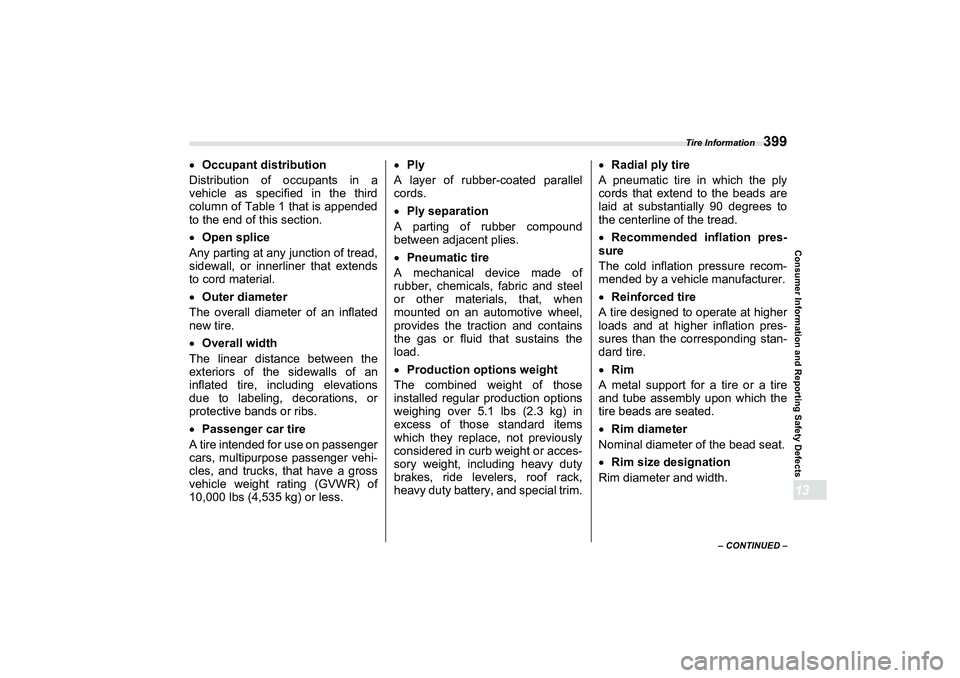
Tire Information
399
Consumer Information and Reporting Safety Defects13
– CONTINUED –
Occupant distribution
Distribution of occupants in a
vehicle as specified in the third
column of Table 1 that is appended
to the end of this section.
Open splice
Any parting at any junction of tread,
sidewall, or innerliner that extends
to cord material.
Outer diameter
The overall diameter of an inflated
new tire.
Overall width
The linear distance between the
exteriors of the sidewalls of an
inflated tire, including elevations
due to labeling, decorations, or
protective bands or ribs.
Passenger car tire
A tire intended for use on passenger
cars, multipurpose passenger vehi-
cles, and trucks, that have a gross
vehicle weight rating (GVWR) of
10,000 lbs (4,535 kg) or less.
Ply
A layer of rubber-coated parallel
cords.
Ply separation
A parting of rubber compound
between adjacent plies.
Pneumatic tire
A mechanical device made of
rubber, chemicals, fabric and steel
or other materials, that, when
mounted on an automotive wheel,
provides the traction and contains
the gas or fluid that sustains the
load.
Production options weight
The combined weight of those
installed regular production options
weighing over 5.1 lbs (2.3 kg) in
excess of those standard items
which they replace, not previously
considered in curb weight or acces-
sory weight, including heavy duty
brakes, ride levelers, roof rack,
heavy duty battery, and special trim.
Radial ply tire
A pneumatic tire in which the ply
cords that extend to the beads are
laid at substantially 90 degrees to
the centerline of the tread.
Recommended inflation pres-
sure
The cold inflation pressure recom-
mended by a vehicle manufacturer.
Reinforced tire
A tire designed to operate at higher
loads and at higher inflation pres-
sures than the corresponding stan-
dard tire.
Rim
A metal support for a tire or a tire
and tube assembly upon which the
tire beads are seated.
Rim diameter
Nominal diameter of the bead seat.
Rim size designation
Rim diameter and width.
A4600BEscusenvhch13.fm 399 ページ 2021年7月9日 金曜日 午後4時39分
Page 406 of 432
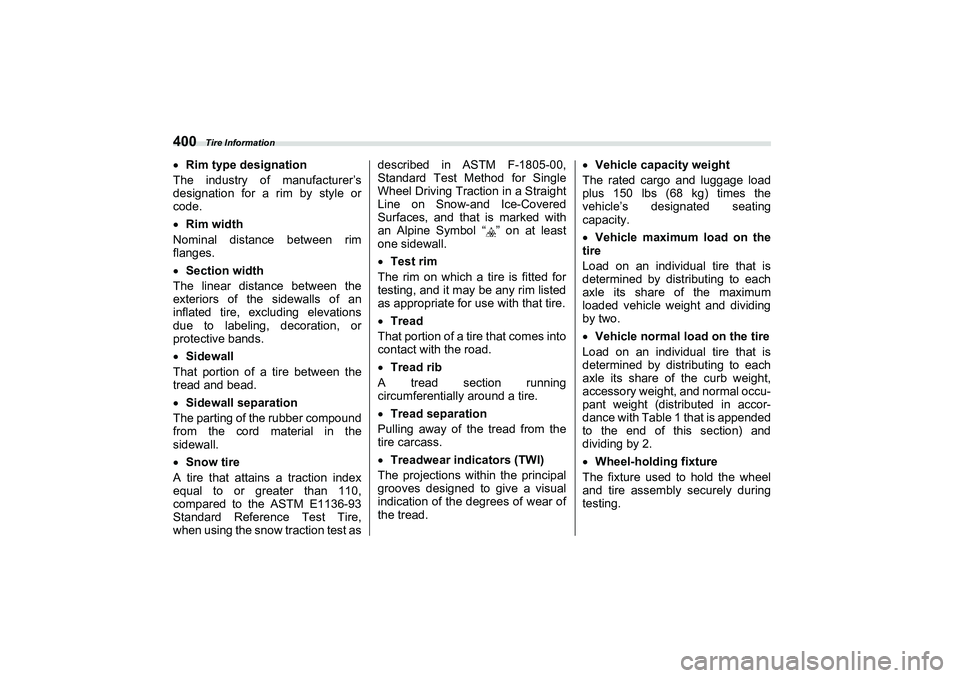
Tire Information
400Rim type designation
The industry of manufacturer’s
designation for a rim by style or
code.
Rim width
Nominal distance between rim
flanges.
Section width
The linear distance between the
exteriors of the sidewalls of an
inflated tire, excluding elevations
due to labeling, decoration, or
protective bands.
Sidewall
That portion of a tire between the
tread and bead.
Sidewall separation
The parting of the rubber compound
from the cord material in the
sidewall.
Snow tire
A tire that attains a traction index
equal to or greater than 110,
compared to the ASTM E1136-93
Standard Reference Test Tire,
when using the snow traction test as described in ASTM F-1805-00,
Standard Test Method for Single
Wheel Driving Traction in a Straight
Line on Snow-and Ice-Covered
Surfaces, and that is marked with
an Alpine Symbol “ ” on at least
one sidewall.
Test rim
The rim on which a tire is fitted for
testing, and it may be any rim listed
as appropriate for use with that tire.
Tread
That portion of a tire that comes into
contact with the road.
Tread rib
A tread section running
circumferentially around a tire.
Tread separation
Pulling away of th e tread from the
tire carcass.
Treadwear indicators (TWI)
The projections within the principal
grooves designed to give a visual
indication of the degrees of wear of
the tread.
Vehicle capacity weight
The rated cargo and luggage load
plus 150 lbs (68 kg) times the
vehicle’s designated seating
capacity.
Vehicle maximum load on the
tire
Load on an individual tire that is
determined by distributing to each
axle its share of the maximum
loaded vehicle weight and dividing
by two.
Vehicle normal load on the tire
Load on an individual tire that is
determined by distributing to each
axle its share of the curb weight,
accessory weight, and normal occu-
pant weight (distributed in accor-
dance with Table 1 that is appended
to the end of this section) and
dividing by 2.
Wheel-holding fixture
The fixture used to hold the wheel
and tire assembly securely during
testing.A4600BEscusenvhch13.fm 400 ページ 2021年7月9日 金曜日 午後4時39分
Page 408 of 432

Tire Information
402sures and make sure the wheel nuts
are correctly tightened. For informa-
tion about the tightening torque and
tightening sequence for the wheel
nuts, refer to
"Flat Tires"
P303.
■
Vehicle Load Limit – How to
Determine
The load capacity of your vehicle is
determined by weight, not by avail-
able cargo space. The load limit of
your vehicle is shown on the vehicle
placard attached to the driver’s side
B-pillar. Locate the statement “
The
combined weight of occupants and cargo
should never exceed XXX kg or XXX lbs
”
on your vehicle’s placard.
The vehicle placard also shows
seating capacity of your vehicle.
The total load capacity includes the
total weight of driver and all passen-
gers and their belongings, any
cargo, any optional equipment such
as a trailer hitch, roof rack or bike
carrier, etc., and the tongue load of
a trailer. Therefore cargo capacity
can be calculated by the following
method. Cargo capacity = Load limit
− (total
weight of occupants + total weight of
optional equipment)
For information about vehicle
loading, refer to
"Loading Your Vehicle"
P297.▼
Calculating total and load
capacities varying seating
configurations
Calculate the available load
capacity as shown in the following
examples:
Example 1A Vehicle capacity weight of the
vehicle is 800 lbs (363 kg), which is
indicated on the vehicle placard with
the statement “The combined
weight of occupants and cargo
should never exceed 363 kg or 800
lbs”.
For example, if the vehicle has one
occupant weighing 154 lbs (70 kg)
CAUTION
Your vehicle is neither
designed nor intended to be
used for trailer towing. There-
fore, never tow a trailer with
your vehicle.
D00245
A4600BEscusenvhch13.fm 402 ページ 2021年7月>7日 5 曜日 午後>2時>1>7分
Page 409 of 432
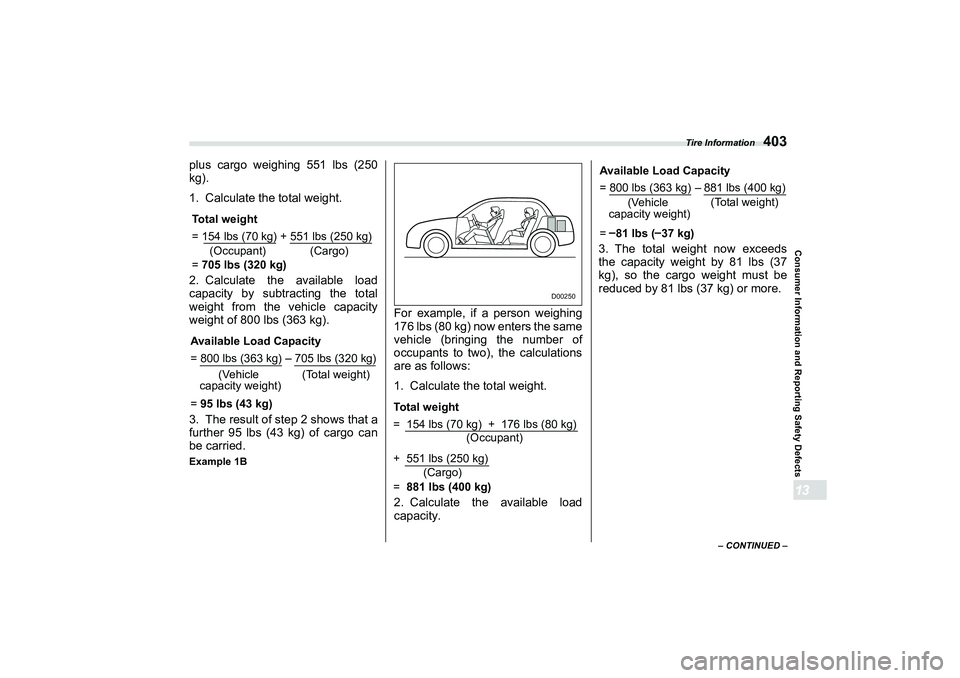
Tire Information
403
Consumer Information and Reporting Safety Defects13
– CONTINUED –
plus cargo weighing 551 lbs (250
kg).
1. Calculate the total weight.
2. Calculate the available load
capacity by subtracting the total
weight from the vehicle capacity
weight of 800 lbs (363 kg).
3. The result of step 2 shows that a
further 95 lbs (43 kg) of cargo can
be carried.Example 1B
For example, if a person weighing
176 lbs (80 kg) now enters the same
vehicle (bringing the number of
occupants to two), the calculations
are as follows:
1. Calculate the total weight.
2. Calculate the available load
capacity.3. The total weight now exceeds
the capacity weight by 81 lbs (37
kg), so the cargo weight must be
reduced by 81 lbs (37 kg) or more.
Total weight
= 154 lbs (70 kg) + 551 lbs (250 kg)
= 705 lbs (320 kg)
(Occupant) (Cargo)
Available Load Capacity
= 800 lbs (363 kg) 705 lbs (320 kg)
= 95 lbs (43 kg)
(Vehicle
capacity weight) (Total weight)
D00250
Total weight
= 154 lbs (70 kg) + 176 lbs (80 kg)
+ 551 lbs (250 kg)
= 881 lbs (400 kg)
(Occupant)
(Cargo)
Available Load Capacity
= 800 lbs (363 kg) 881 lbs (400 kg)
= 81 lbs ( 37 kg)
(Vehicle
capacity weight) (Total weight)
A4600BEscusenvhch13.fm 403 ページ 2021年7月>7日 5 曜日 午後>2時>1>7分
Page 410 of 432
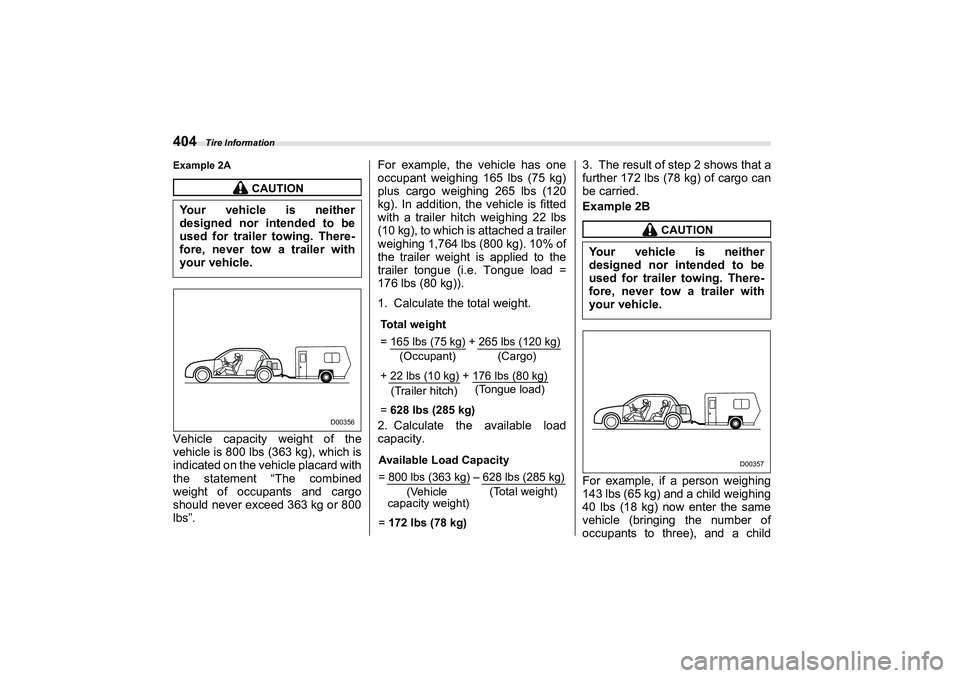
Tire Information
404Example 2AVehicle capacity weight of the
vehicle is 800 lbs (363 kg), which is
indicated on the vehicle placard with
the statement “The combined
weight of occupants and cargo
should never exceed 363 kg or 800
lbs”.For example, the vehicle has one
occupant weighing 165 lbs (75 kg)
plus cargo weighing 265 lbs (120
kg). In addition, the vehicle is fitted
with a trailer hitch weighing 22 lbs
(10 kg), to which is attached a trailer
weighing 1,764 lbs (800 kg). 10% of
the trailer weight
is applied to the
trailer tongue (i.e. Tongue load =
176 lbs (80 kg)).
1. Calculate the total weight.
2. Calculate the available load
capacity. 3. The result of step 2 shows that a
further 172 lbs (78 kg) of cargo can
be carried.
Example 2B
For example, if a person weighing
143 lbs (65 kg) and a child weighing
40 lbs (18 kg) now enter the same
vehicle (bringing the number of
occupants to three), and a child
CAUTION
Your vehicle is neither
designed nor intended to be
used for trailer towing. There-
fore, never tow a trailer with
your vehicle.
D00356
Total weight
= 165 lbs (75 kg) + 265 lbs (120 kg)
+ 22 lbs (10 kg) + 176 lbs (80 kg)
= 628 lbs (285 kg)
(Occupant) (Cargo)
(Trailer hitch) (Tongue load)
Available Load Capacity
= 800 lbs (363 kg) 628 lbs (285 kg)
= 172 lbs (78 kg)
(Vehicle
capacity weight) (Total weight)
CAUTION
Your vehicle is neither
designed nor intended to be
used for trailer towing. There-
fore, never tow a trailer with
your vehicle.
D00357
A4600BEscusenvhch13.fm 404 ページ 2021年7月>7日 5 曜日 午後>2時>1>7分
Page 411 of 432
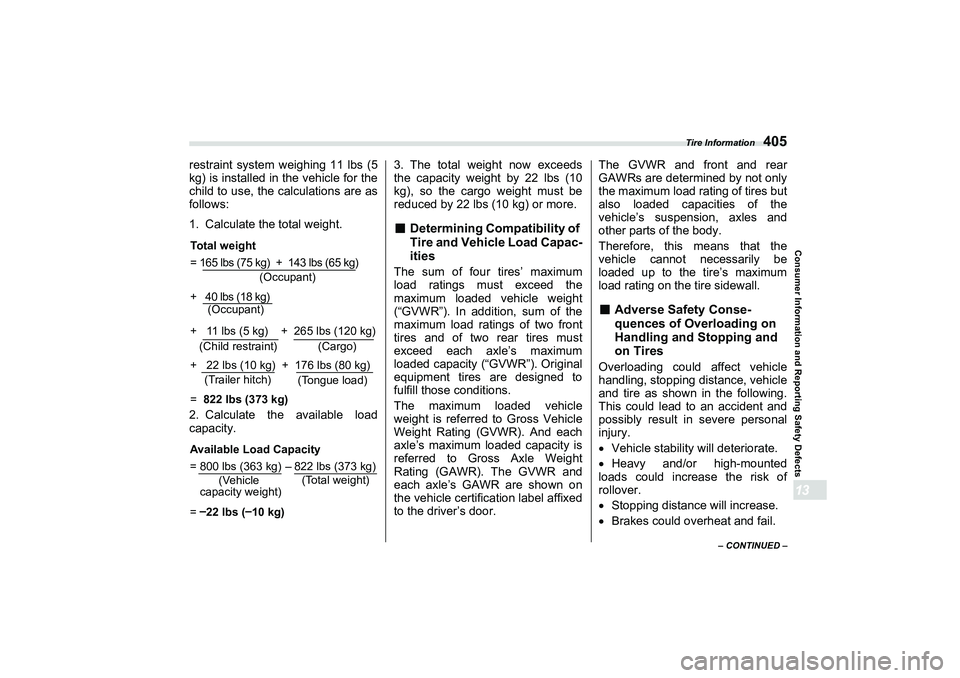
Tire Information
405
Consumer Information and Reporting Safety Defects13
– CONTINUED –
restraint system weighing 11 lbs (5
kg) is installed in the vehicle for the
child to use, the calculations are as
follows:
1. Calculate the total weight.
2. Calculate the available load
capacity.3. The total weight now exceeds
the capacity weight by 22 lbs (10
kg), so the cargo weight must be
reduced by 22 lbs (10 kg) or more.
■
Determining Compatibility of
Tire and Vehicle Load Capac-
itiesThe sum of four tires’ maximum
load ratings must exceed the
maximum loaded vehicle weight
(“GVWR”). In addition, sum of the
maximum load ratings of two front
tires and of two rear tires must
exceed each axle’s maximum
loaded capacity (“GVWR”). Original
equipment tires are designed to
fulfill those conditions.
The maximum loaded vehicle
weight is referred to Gross Vehicle
Weight Rating (GVWR). And each
axle’s maximum loaded capacity is
referred to Gross Axle Weight
Rating (GAWR). The GVWR and
each axle’s GAWR are shown on
the vehicle certification label affixed
to the driver’s door. The GVWR and front and rear
GAWRs are determined by not only
the maximum load rating of tires but
also loaded capacities of the
vehicle’s suspension, axles and
other parts of the body.
Therefore, this means that the
vehicle cannot necessarily be
loaded up to the tire’s maximum
load rating on the tire sidewall.
■
Adverse Safety Conse-
quences of Overloading on
Handling and Stopping and
on TiresOverloading could affect vehicle
handling, stopping distance, vehicle
and tire as shown in the following.
This could lead to an accident and
possibly result in severe personal
injury.
Vehicle stability will deteriorate.
Heavy and/or high-mounted
loads could increase the risk of
rollover.
Stopping distance will increase.
Brakes could overheat and fail.
Total weight
= 165 lbs (75 kg) + 143 lbs (65 kg)
+ 40 lbs (18 kg)
+ 11 lbs (5 kg) + 265 lbs (120 kg)
+ 22 lbs (10 kg) + 176 lbs (80 kg)
= 822 lbs (373 kg) (Occupant)
(Cargo)
(Trailer hitch)
(Child restraint)
(Tongue load)
(Occupant)Available Load Capacity
= 800 lbs (363 kg) 822 lbs (373 kg)
=
22 lbs ( 10 kg)(Vehicle
capacity weight) (Total weight)
A4600BEscusenvhch13.fm 405 ページ 2021年7月9日 金曜日 午後4時39分
Page 412 of 432
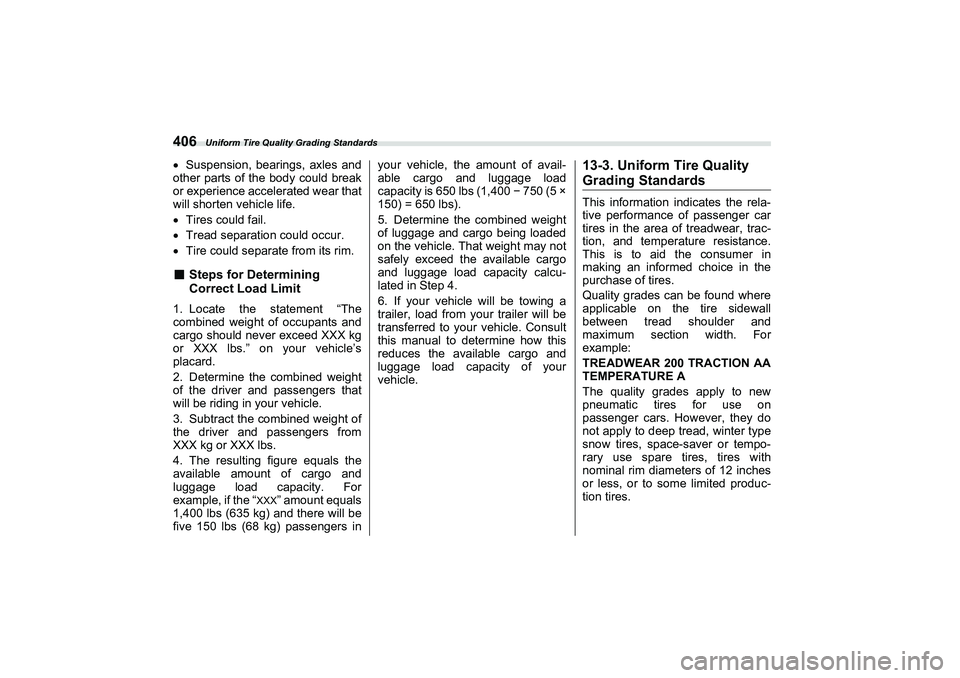
Uniform Tire Quality Grading Standards
406Suspension, bearings, axles and
other parts of the body could break
or experience accelerated wear that
will shorten vehicle life.
Tires could fail.
Tread separation could occur.
Tire could separate from its rim.■ Steps for Determining
Correct Load Limit1. Locate the statement “The
combined weight of occupants and
cargo should never exceed XXX kg
or XXX lbs.” on your vehicle’s
placard.
2. Determine the combined weight
of the driver and passengers that
will be riding in your vehicle.
3. Subtract the combined weight of
the driver and passengers from
XXX kg or XXX lbs.
4. The resulting figure equals the
available amount of cargo and
luggage load capacity. For
example, if the “
XXX
” amount equals
1,400 lbs (635 kg) and there will be
five 150 lbs (68 kg) passengers in your vehicle, the amount of avail-
able cargo and luggage load
capacity is 650 lbs (1,400
− 750 (5 ×
150) = 650 lbs).
5. Determine the combined weight
of luggage and cargo being loaded
on the vehicle. That weight may not
safely exceed the available cargo
and luggage load capacity calcu-
lated in Step 4.
6. If your vehicle will be towing a
trailer, load from your trailer will be
transferred to your vehicle. Consult
this manual to determine how this
reduces the available cargo and
luggage load capacity of your
vehicle.
13-3. Uniform Tire Quality Grading StandardsThis information i ndicates the rela-
tive performance of passenger car
tires in the area of treadwear, trac-
tion, and temperature resistance.
This is to aid the consumer in
making an informed choice in the
purchase of tires.
Quality grades can be found where
applicable on the tire sidewall
between tread shoulder and
maximum section width. For
example:
TREADWEAR 200 TRACTION AA
TEMPERATURE A
The quality grades apply to new
pneumatic tires for use on
passenger cars. However, they do
not apply to deep tread, winter type
snow tires, space-saver or tempo-
rary use spare tires, tires with
nominal rim diameters of 12 inches
or less, or to some limited produc-
tion tires.
A4600BEscusenvhch13.fm 406 ページ 2021年7月9日 金曜日 午後4時39分
Page 420 of 432

Index
414GAWR (Gross Axle Weight Rating) .....................................P299
G-force .................................................................................P154
G-force (peak hold function).................................................P154
Glove box .............................................................................P214
GVWR (Gross Vehicle Weight Rating).................................P299HHazard warning flasher ............................................. P127, P302
Head restraint adjustment ......................................................P34
Headlight Aim adjustment ................................................................P374
Beam leveler....................................................................P182
Bulb replacement.............................................................P373
Bulb wattage ....................................................................P388
Control switch ..................................................................P174
Flasher.............................................................................P176
Indicator light ...................................................................P150
Welcome lighting function................................................P175
High Beam Assist Function ...........................................................................P177
Indicator light ...................................................................P150
High beam indicator light......................................................P150
High/low beam change (dimmer) .........................................P176
Hill start assist ......................................................................P257 Indicator light ...................................................................P150
To activate/deactivate............... .......................................P259
HomeLink
®...........................................................................P186 Hook
Towing and tie-down....................................................... P320
Horn..................................................................................... P195
Hose and connections ... ................................................ ...... P348
IIcy road surface warning light...... ........................................ P151
Illumination brightness control ............................................. P130
Immobilizer .......................................................................... P108
Indicator light (security indicato r light) ............................ P148
Indicator light BSD/RCTA OFF ............................................................. P150
BSD/RCTA warning ........................................................ P150
Cruise control.................................................................. P149
Cruise control set ............................................................ P149
Door open ....................................................................... P141
Drive mode ..................................................................... P148
Front passenger’s frontal airbag ON and OFF ....... P71, P135
Headlight......................................................................... P150
High beam ...................................................................... P150
High Beam Assist ........................................................... P150
Hill start assist ........ ................................................... ...... P150
Malfunction ..................................................................... P136
RAB OFF ........................................................................ P151
REV ................................................................................ P130
Security ........................................................................... P148
Select lever/Gear position....... ........................................ P149
Steering Responsive Headlight OFF .............................. P150
TRAC OFF ...................................................................... P142
B�5�=�B�8.�E�R�R�N 414 ページ 2021年7月5日 月曜日 午後>1時>1>1分